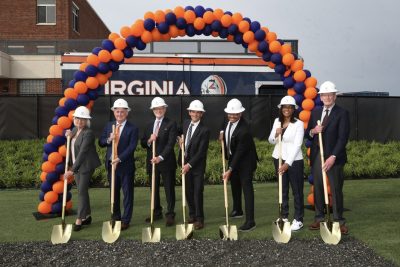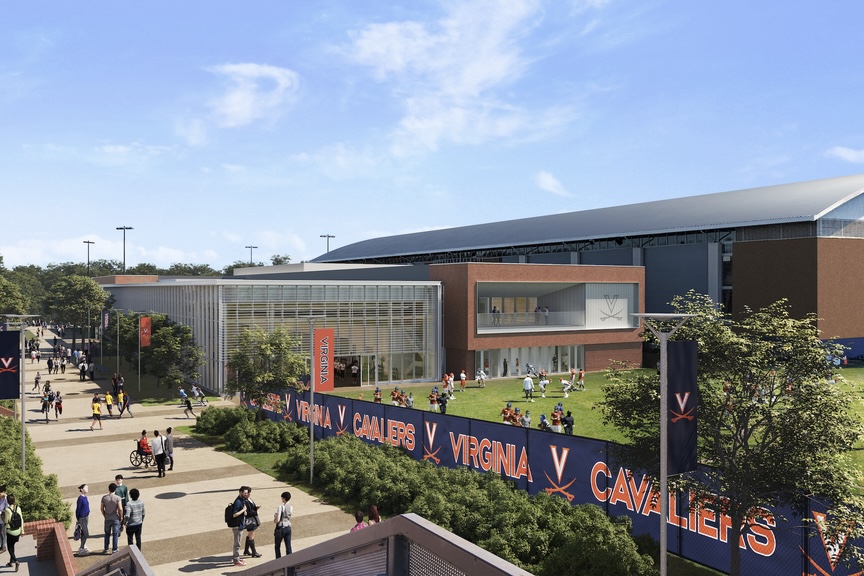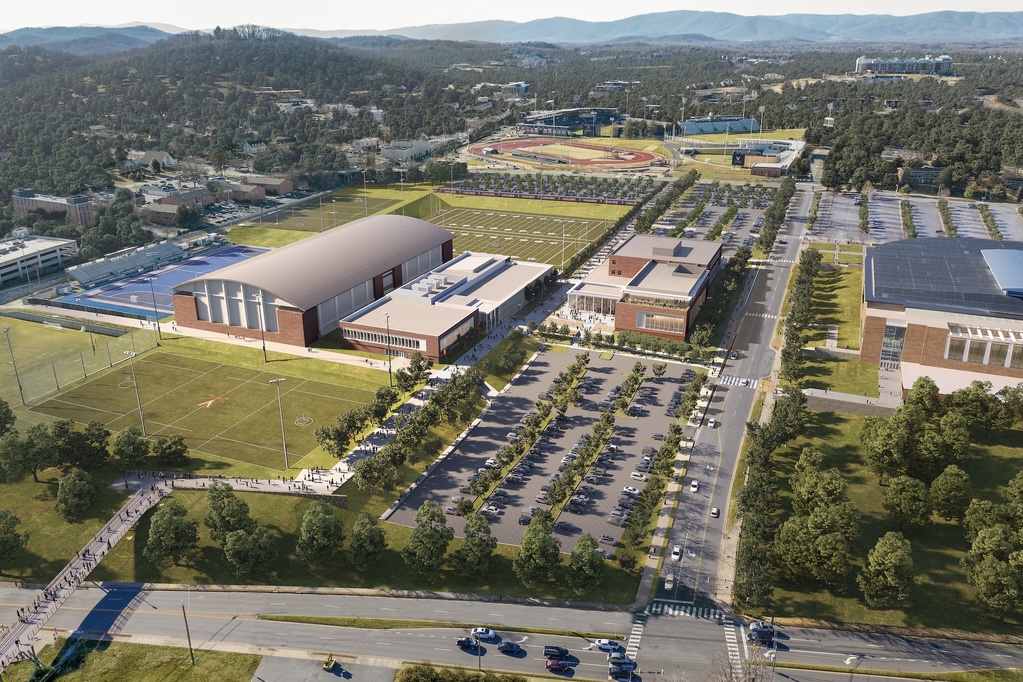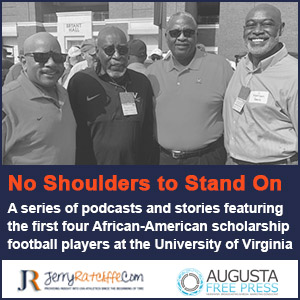Virginia breaks ground on new, $80 million football home
By Jerry Ratcliffe
Dead last. That’s how former Virginia football coach Bronco Mendenhall described the state of the Cavaliers’ support football facilities to both athletics director Carla Williams and the school’s board of visitors last August.
Dead last in the ACC, meaning UVA lagged behind Duke, Wake Forest, Syracuse, Georgia Tech and all the rest of the conference when it came to providing a home for its football team. The McCue Center was ancient as compared to today’s facilities around the league.
Williams knew that her second day on the job when she took a tour of facilities and “saw the need.” Her office, by the way, sits atop of the football offices, locker room, weight room, meeting rooms and sports medicine. She didn’t require a second look around to realize how bad things were.
It wasn’t exactly a secret. Al Groh told the athletic administration about it after the ACC expanded and brought in schools that had traditional winning football programs and better facilities. His warning was ignored, something the administration admitted was a mistake years later.
Groh’s successor, Mike London, harped over the same issues but at least managed to get the George Welsh Indoor Football Facility during his six years, thanks in part to former Wahoo player Chris Long. One of the first statements out of Bronco’s mouth when he took the job was how badly UVA needed a new facility to house the football program. He even donated $500,000 to the cause and is still updated on the progress by Williams because he cares.
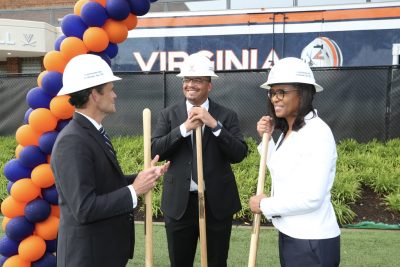 Thursday was a HUGE day for Virginia football in that Williams, new coach Tony Elliott and other representatives from the university put shovels in the dirt at the site of the new building in a major facilities groundbreaking. The building, which will be constructed in between McCue and the Welsh Indoor (see attached renderings), is essentially paid for.
Thursday was a HUGE day for Virginia football in that Williams, new coach Tony Elliott and other representatives from the university put shovels in the dirt at the site of the new building in a major facilities groundbreaking. The building, which will be constructed in between McCue and the Welsh Indoor (see attached renderings), is essentially paid for.
That’s $80 million for the 90,000 square-foot facility, which won’t be ready for the football program until the spring of 2025. The Olympic sports building, which will be nestled in between McCue and the new football complex (naming rights are still available for both buildings), will come after and still requires more fundraising.
“So with the completion of this facility, having made the enhancements we’ve already made from a personnel standpoint, which was huge, we’re in a much, much better place,” Williams said Thursday prior to the groundbreaking ceremony. “I think one of the great things about UVA, and one of the things that quite frankly attracted me to UVA, is that every sport has the university to sell in recruiting. You can never underestimate the value of a UVA degree, education. All of our coaches use that [in recruiting]. I use that.
“So the facilities will enhance that. The personal additions will enhance that. We’re on our way. We’ve got a lot to do because no one’s standing still.”
When the new football operations center is completed, there’s no way to really judge where Virginia will rank against its fellow 13 programs in the ACC.
As Williams succinctly put it: “It is not flashy, but it’s exactly what we need.”
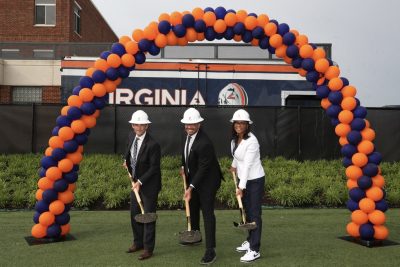 In other words, UVA’s building will not have a “slide” that can transport players from one level of the facility to another, just for fun. The slide was one of several “fun” features added to Clemson’s facility, built six years ago.
In other words, UVA’s building will not have a “slide” that can transport players from one level of the facility to another, just for fun. The slide was one of several “fun” features added to Clemson’s facility, built six years ago.
We had the pleasure of a personal tour to Oregon’s unique football operations facility when UVA played in Eugene several years ago, one that featured a barber shop, hot tubs for the coaching staff and all the window dressings to catch the eye of visiting 18-year-old prospects. Several schools have followed suit.
Virginia isn’t about flash, but rather efficiency, which was something that both Mendenhall and Elliott stressed.
Elliott, whose office was in the Clemson facility before he became UVA’s head coach, said at the groundbreaking that it symbolized a commitment by the university to how important football is to the school.
“From the recruiting standpoint it’s going to help, because the kids get to see on the front end what the investment is and the commitment is to our football program,” Elliott said.
Rival schools have negatively recruited against Virginia because of outdated facilities, but that argument is no longer valid. Elliott and his recruiters can show off the future site and renderings of the building and where future players can call it home.
“We’ll let that be a rocket launcher for the program,” Elliott said, noting how the entire complex, when completed, will benefit the entire athletic program.
Williams pointed out that efficiency was a focal point.
“What’s really special about our facility is, I think, the efficiency that we are going to create, because everything is right there,” she said. “You’ve got the indoor that opens to the natural grass practice fields. Then you’ll have the facility with the weight room that opens to the natural grass practice field, next door to the indoor.
“Everything that they need will be in one place. I think if you look around the country, that isn’t always the case for some facilities. We have tried to focus on the need and meeting the need of our student-athletes.”
Perhaps the most important thing that Williams said during her press conference had to be encouraging to potential recruits and UVA fans.
“There’s no reason why a premier academic institution cannot thrive in football,” Williams proclaimed. “No reason.”
𝙁𝙪𝙩𝙪𝙧𝙚 𝙃𝙤𝙤𝙨, 𝙒𝙚’𝙫𝙚 𝙡𝙖𝙞𝙙 𝙩𝙝𝙚 𝙁𝙤𝙪𝙣𝙙𝙖𝙩𝙞𝙤𝙣. 𝙉𝙤𝙬 𝙞𝙩’𝙨 𝙩𝙞𝙢𝙚⌚️𝙩𝙤 𝙗𝙪𝙞𝙡𝙙 𝙤𝙪𝙧 𝙣𝙚𝙬 𝙝𝙤𝙢𝙚🚧🔨. #𝘾𝙤𝙣𝙨𝙩𝙧𝙪𝙘𝙩𝙞𝙤𝙣𝙋𝙝𝙖𝙨𝙚#GoHoos⚔️ pic.twitter.com/F1zYoRiK7d
— Virginia Football (@UVAFootball) June 2, 2022



